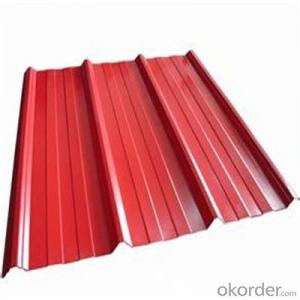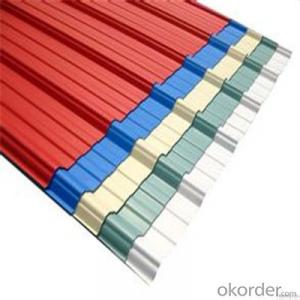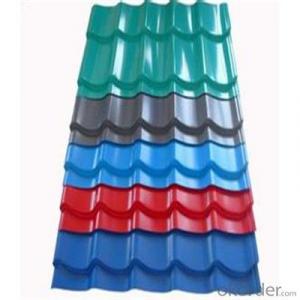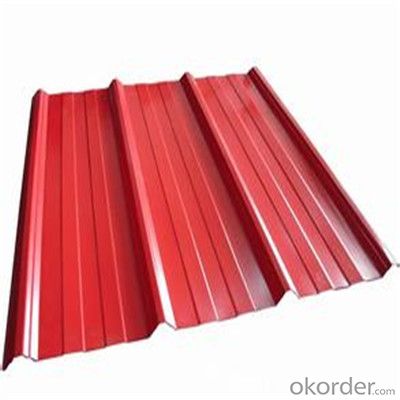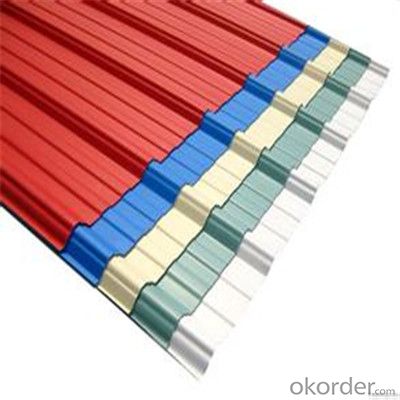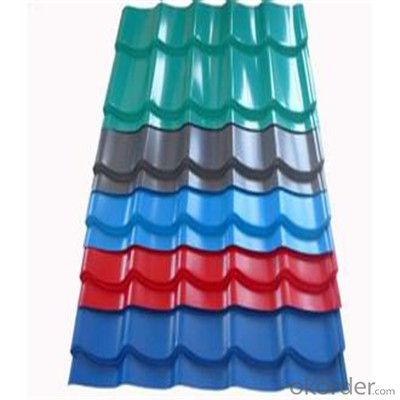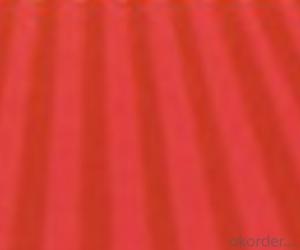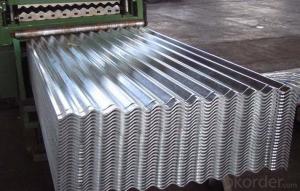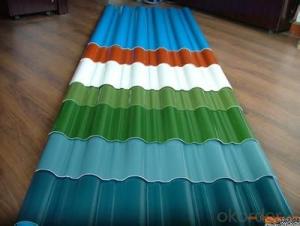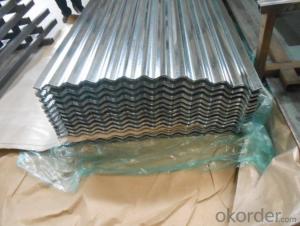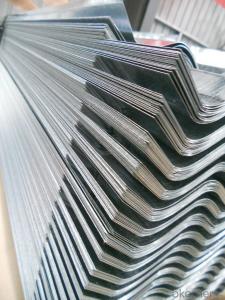Color Coated Galvanized Corrugated Steel Sheet
- Loading Port:
- Shanghai
- Payment Terms:
- TT OR LC
- Min Order Qty:
- 50 m.t.
- Supply Capability:
- 1000000 m.t./month
OKorder Service Pledge
OKorder Financial Service
You Might Also Like
Specification
Description of Prepainted Corrugated Iron Sheet:
1) Standard:JIS G3312,EN10169, GB/T-12754-2006
2) Thickness range:0.23mm-1.2mm
3) Width range:700mm-1250mm
4) Zinc Weight:70g/m2-300g/m2
5) Zinc spangle:Regular,Minimum
6) Coil weight: 3MT-10MT
Specifications of Prepainted Corrugated Iron Sheet:
1) Buildings and constructions: roofing, ceilings, gutters, venting lines, indoor decorations, window frames, etc.
2) Electrical appliances: computer shells, washing machines, refrigerators, dehumidifiers, video recorders, water heaters, etc.
3) Agricultural equipments: troughs, feeding tools, agricultural driers, irrigation channels, etc.
4) Vehicle parts: back-seat plates of buses and trucks, conveying systems, oil tanks, etc.
Features of Prepainted Corrugated Iron Sheet:
Galvanized steel coil products are mainly applied to building, light industry, automobile, agriculture and animal husbandry fishery. In construction industry, it is mainly used to produce anti-corrosion of industrial and civil building roof, roof grille.
Images of Prepainted Corrugated Iron Sheet:
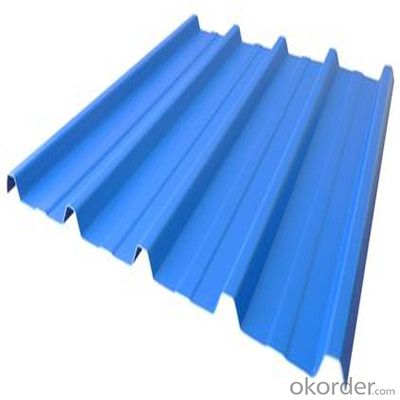
FAQ:
1. What's the Delivery port?
The main ports are Qingdao and Tianjin, we also can deliver to other ports to meet your requirements
2. How long is the lead time?
Delivery time: 45 days after order confirmed.
3. What payment term do you accept?
Payment: T/T or L/C at sight.
- Q: Can steel sheets be used for magnetic applications?
- Yes, steel sheets can be used for magnetic applications. However, it is important to note that not all types of steel are magnetic. Steel can be classified into two main categories: ferromagnetic and non-ferromagnetic. Ferromagnetic steel contains iron, nickel, and cobalt, which are materials that can be magnetized. On the other hand, non-ferromagnetic steel does not contain these materials and is not magnetic. Ferromagnetic steel sheets are commonly used in magnetic applications such as transformers, motors, generators, and magnetic shielding. They are preferred for these applications because they can easily conduct and amplify magnetic fields. Non-ferromagnetic steel sheets, although not magnetic themselves, can still be used in magnetic applications as structural components or as part of a magnetic system where the magnetic field is being controlled or manipulated. When selecting steel sheets for magnetic applications, it is important to consider the specific magnetic properties required for the intended application and choose the appropriate type of steel accordingly.
- Q: Can steel sheets be bent without cracking?
- Yes, steel sheets can be bent without cracking. However, the extent to which they can be bent without cracking largely depends on the type and thickness of the steel sheet, as well as the bending process and equipment used.
- Q: How do steel sheets handle water resistance?
- Steel sheets handle water resistance very well due to their inherent properties. Steel is a non-porous material, meaning it does not absorb water. Additionally, steel sheets are often coated with protective layers, such as galvanized or stainless steel finishes, which provide an extra barrier against water penetration. This makes steel sheets highly resistant to corrosion, rust, and water damage, making them suitable for various applications, including roofing, construction, and marine environments.
- Q: What is the typical elongation of a steel sheet?
- The typical elongation of a steel sheet can vary depending on the specific grade and thickness of the sheet. However, as a general guideline, the typical elongation for a steel sheet can range from 20% to 40% before it reaches its breaking point.
- Q: Can steel sheets be used for security doors and windows?
- Yes, steel sheets can be used for security doors and windows. Steel is a strong and durable material that provides enhanced security and protection against break-ins and forced entry. It is commonly used in the construction of security doors and windows due to its strength and resistance to impact and tampering.
- Q: How are steel sheets stored to prevent damage?
- Steel sheets are typically stored in a vertical position, supported by racks or shelves, to prevent bending or warping. They may also be stored horizontally, with protective padding between each sheet to prevent scratching or other surface damage. Additionally, steel sheets are often stored in a controlled environment to avoid exposure to moisture, which can cause rusting.
- Q: What is the difference between a galvalume and galvanized steel sheet?
- The coating applied to the surface of galvalume and galvanized steel sheets is what sets them apart. Galvalume steel sheets are coated with an aluminum-zinc alloy, whereas galvanized steel sheets are coated with zinc. The coating on galvalume steel sheets offers better corrosion resistance compared to galvanized steel sheets. The combination of aluminum and zinc forms a protective barrier that prevents rusting and corrosion, even in harsh environments. Moreover, galvalume steel sheets have superior heat reflectivity compared to galvanized steel sheets. This makes them more energy-efficient in hot climates, as they reflect a larger portion of the sun's heat, reducing cooling expenses. Additionally, galvalume steel sheets have better resistance to scratches and fingerprints due to their unique coating composition. This makes them more visually appealing and easier to maintain in comparison to galvanized steel sheets. When it comes to price, galvalume steel sheets are generally costlier than galvanized steel sheets due to the added benefits and higher quality of the coating. However, the long-term cost-effectiveness of galvalume steel sheets can outweigh the initial higher purchase price. Overall, while both galvalume and galvanized steel sheets offer some level of corrosion protection, galvalume steel sheets provide superior corrosion resistance, heat reflectivity, and aesthetic appeal. Therefore, the choice between the two depends on the specific requirements of the project and the environmental conditions the steel sheet will be exposed to.
- Q: What are the different surface textures for galvanized steel sheets?
- There are several different surface textures available for galvanized steel sheets, including smooth, diamond-patterned, and textured.
- Q: Can steel sheets be used in furniture applications?
- Yes, steel sheets can be used in furniture applications. Steel sheets are commonly used in the construction of various furniture pieces such as tables, chairs, shelving units, and storage cabinets. They provide strength, durability, and a modern aesthetic to furniture designs. Additionally, steel sheets can be easily formed and shaped into different configurations, making them versatile for various furniture styles and functions.
- Q: Can steel sheets be used for mezzanine flooring?
- Indeed, mezzanine flooring can make use of steel sheets. Mezzanine flooring benefits from the numerous advantages provided by steel sheets, such as their strength, durability, and versatility. Steel sheets are capable of withstanding substantial loads and offer a dependable and stable solution for flooring needs. Moreover, they can be easily tailored to suit specific dimensions and requirements, making them adaptable for various mezzanine designs. Additionally, steel sheets exhibit resistance to fire, moisture, and pests, guaranteeing a flooring option that is long-lasting and requires minimal maintenance. In summary, due to their robustness, durability, and adaptability, steel sheets are a popular choice for mezzanine flooring.
Send your message to us
Color Coated Galvanized Corrugated Steel Sheet
- Loading Port:
- Shanghai
- Payment Terms:
- TT OR LC
- Min Order Qty:
- 50 m.t.
- Supply Capability:
- 1000000 m.t./month
OKorder Service Pledge
OKorder Financial Service
Similar products
Hot products
Hot Searches
Related keywords
